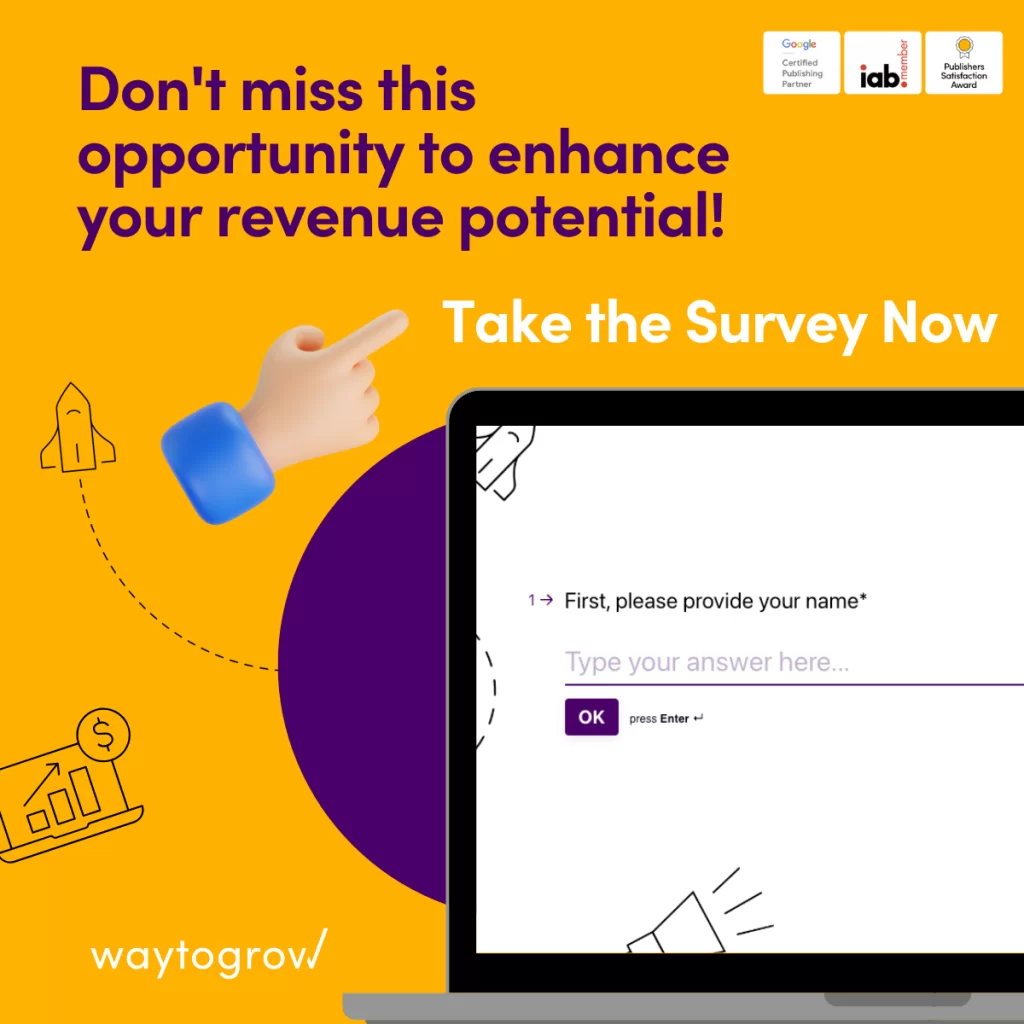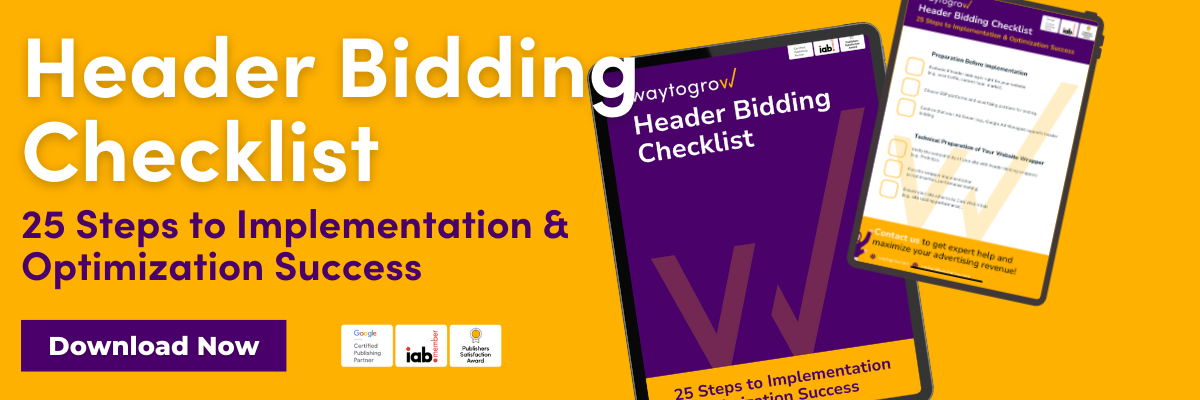- eCPM – what is it?
- Ad Requests & Ad Impressions eCPM
- Why does eCPM count for publishers?
- eCPM vs CPM
- The best way to track eCPM for publishers
- Ways to increase Publishers eCPM
- How high eCPM can I reach?
- What can affect the publisher’s eCPM?
- CPM Floor – how does it help publishers?
- Low publisher’s eCPM reasons
- Summary
- Ready to optimize your eCPM and boost ad revenue?
For publishers, eCPM (effective Cost Per Mille) is a critical metric affecting ad revenue potential. It measures revenue per 1,000 ad impressions, helping publishers understand which placements and ad inventory perform best and allowing them to fine-tune their ad strategy. A higher eCPM generally means more efficient monetization without increasing ad volume or impacting user experience. In this guide, we explore the importance of eCPM, how to track it, and actionable strategies to maximize it through optimized traffic, targeted placements, and effective ad formats.
Understanding and regularly analyzing eCPM, including the influence of ad requests, impressions, user demographics, and device types, empowers publishers to make informed decisions that drive sustainable revenue growth. From implementing header bidding to adjusting ad placements and setting an eCPM floor, optimizing eCPM is essential for achieving maximum ad revenue without compromising audience experience.
eCPM – what is it?

eCPM is the metric publishers need to track their ad spaces’ performance. By measuring revenue per thousand impressions, eCPM reveals which ad placements are the most lucrative and helps optimize your ad stack. With a focus on both fill rate and bid rates, higher eCPMs mean smarter monetization. At Waytogrow, we’re dedicated to helping you unlock those insights and increase eCPM, driving sustainable revenue across your entire inventory.
If you’d like more insight into optimizing eCPM, we are here to help!
Ad Requests & Ad Impressions eCPM

In the ad tech space, Ad Requests and Impressions are essential metrics directly influencing eCPM (effective cost per thousand impressions). An Ad Request happens whenever your site asks for an ad from the ad server, while an Ad Impression counts each time an ad is successfully displayed.
Why does eCPM count for publishers?

ECPM (effective cost per thousand impressions) is a key indicator of ad revenue potential for publishers. It reflects a publisher’s earnings per 1,000 ad impressions and is influenced by factors like ad placements, audience engagement, and fill rates. A higher eCPM indicates that ads are being valued and priced well by advertisers, which directly correlates to increased revenue. Optimizing eCPM can make each ad placement more profitable, supporting sustainable revenue growth without increasing the number of ads or compromising user experience.
eCPM vs CPM

eCPM (Effective Cost Per Mille) and CPM (Cost Per Mille) are both metrics in digital advertising, but they serve different purposes:
- CPM is the cost an advertiser pays for 1,000 ad impressions, showing what advertisers are willing to pay to display ads. It’s typically set by the advertiser and reflects their budget and campaign objectives.
- eCPM represents the revenue a publisher earns per 1,000 impressions. It’s calculated by dividing total revenue by the number of impressions, then multiplying by 1,000. eCPM helps publishers measure their ad space’s profitability across all ad types and placements, ensuring they maximize revenue.
In short, CPM is an advertiser’s pricing metric, while eCPM is a publisher’s revenue metric that guides optimization efforts.
The best way to track eCPM for publishers

The best way for publishers to track eCPM is by using real-time analytics platforms that monitor revenue, impressions, and fill rates. These platforms provide a breakdown of eCPM across different ad placements, formats, and audience segments. Integrating a dedicated analytics dashboard, such as the one Waytogrow offers, allows publishers to see performance insights, identify trends, and adjust their ad strategy on the go. Tracking eCPM regularly helps publishers optimize ad inventory for maximum revenue potential.
Ways to increase Publishers eCPM

Here are effective ways to increase eCPM for publishers:
- Optimize Ad Placement: Position ads in high-visibility areas above the fold to attract more engagement and higher bids.
- Implement Header Bidding: Enable multiple demand sources to bid in real-time, increasing competition and CPM rates.
- Use Audience Segmentation: Target high-value audience segments with relevant ads to increase bidding interest.
- Improve Page Load Speed: Faster-loading pages lead to higher viewability rates, improving eCPM.
- Experiment with Ad Formats: Test formats like video, native ads, or interactive ads that often command higher CPMs.
Regular analysis and adjustments based on these tactics will help publishers maximize eCPM and revenue potential.
How high eCPM can I reach?

The potential eCPM you can reach varies greatly based on factors like audience demographics, content type, ad format, and traffic source. Premium ad formats, such as video ads or high-impact placements above the fold, generally yield higher eCPMs, especially for audiences in desirable regions like the U.S. or Western Europe. Typical eCPMs can range from $1-$3 for standard display ads, up to $10-$20+ for premium formats like video or native ads with high engagement. Optimizing these elements and using strategies like header bidding can help you reach the highest possible eCPM.
What can affect the publisher’s eCPM?

Several factors influence a publisher’s eCPM, including:
- Audience Demographics: Audience Demographics: High-value demographics, especially audiences from regions like North America and Western Europe, typically command higher eCPMs. This premium traffic segment is highly attractive to advertisers, as these users often have more purchasing power and engagement potential.
- Ad Format: Video and interactive ads often deliver higher eCPMs than standard display ads. Their engaging, dynamic nature captures more audience attention, making them highly attractive to advertisers seeking impactful ad placements.
- Ad Placement: Positioning ads above the fold or in prominent, high-visibility spots leads to stronger engagement and higher revenue. These placements capture user attention faster, making them ideal for maximizing eCPM.
- Traffic Quality and Source: Direct and organic traffic sources tend to produce higher eCPMs than lower-quality traffic. These sources usually bring engaged users, which drives up value for advertisers and improves overall ad revenue.
- Seasonality: eCPMs tend to rise during peak ad spending times, like holidays or major sales events. These periods bring increased demand from advertisers, leading to higher bids and greater revenue potential for publishers.
- Visitor Uniqueness: Repeated visitors and unique visits impact ad performance differently. Unique visitors are particularly valuable, as they tend to drive higher CPMs compared to recurring visitors. This is because advertisers are often willing to pay a premium for fresh, first-time impressions, which tend to generate stronger engagement. Tracking and increasing unique traffic can be a smart approach to lifting eCPM and overall revenue, ensuring you’re maximizing the value of each ad impression.
- User Performance: While publishers may not have direct control over traffic performance, the actions users take on other platforms can significantly impact eCPM. Understanding what constitutes “quality traffic” for advertising, and examining how it performs, is essential. By analyzing these factors, publishers can tailor strategies that attract high-value visitors, leading to improved eCPM and better revenue outcomes.
- Fill Rates: The percentage of ad units that successfully display an ad when there’s an opportunity directly influences eCPM. Reaching optimal fill rates (close to 100%) significantly impacts ad revenue, maximizing the potential of each ad placement.
- User Device Type: The type of device a user is on—desktop, mobile, or tablet—directly impacts ad performance.
Optimizing these elements helps maximize the publisher’s eCPM.
CPM Floor – how does it help publishers?

Setting an CPM Floor involves establishing a minimum price per 1,000 impressions that advertisers must meet to display ads on your site. This strategy helps ensure that lower-value ads don’t take up premium inventory, thus protecting revenue and keeping CPMs competitive. By carefully adjusting CPM Floors, publishers can drive up overall earnings and prevent undervaluation of their ad space while maintaining an optimal balance between fill rate and revenue.
Low publisher’s eCPM reasons

Here are some common reasons for low eCPM:
- Low-Quality Traffic: Traffic from regions or sources with low engagement may yield lower eCPMs, as advertisers place less value on it.
- Poor Ad Placement: Ads placed in low-visibility areas may receive less engagement, impacting eCPM.
- Lack of Demand in Certain Geographies: Limited demand from advertisers in certain regions can reduce eCPM.
- Inadequate Audience Targeting: Ads not aligned with audience interests can lead to lower engagement and eCPM.
Analyzing these factors helps publishers identify areas for improvement.
Summary

eCPM (effective Cost Per Mille) is essential for publishers aiming to maximize revenue, as it reflects earnings per 1,000 ad impressions. By analyzing factors like ad requests, impressions, audience demographics, and device types, publishers can strategically optimize their eCPM. This guide highlights ways to boost eCPM through optimized placements, audience targeting, header bidding, and setting an CPM Floor. Consistent analysis and adjustments help publishers achieve sustainable revenue growth while maintaining a positive user experience, making eCPM optimization a key component in digital ad strategies.
Ready to optimize your eCPM and boost ad revenue?
Let’s explore how Waytogrow can help you unlock the full potential of your ad inventory and boost ad revenue. Whether it’s optimizing placements, implementing header bidding, or setting the right eCPM floor, we have the expertise and tools to elevate your monetization strategy. Reach out today to start driving meaningful results!
Share on:











